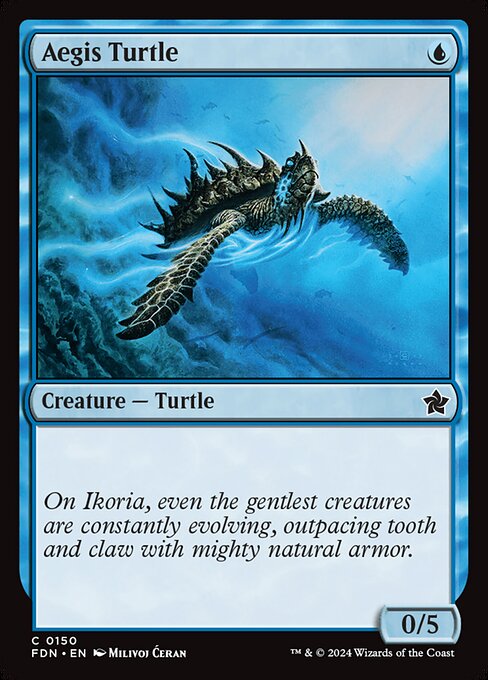
Image courtesy of Scryfall.com
Color Palette and Symbolism: Why Aegis Turtle Speaks Blues and Armor
Blue mana in Magic: The Gathering is the color of intellect, curiosity, and careful planning—think of long island walks, precise calculations, and the patience to outwait a foe. When you pair blue with a resilient shell, you get an image that resonates with MTG players who love to weather the early game and emerge with control of the late game. Aegis Turtle, with its single blue mana cost and a stout 0/5 body, embodies that philosophy: a modest start that grows into a lasting shield for your board. It’s a gentle giant in the color wheel’s bustling ocean, the kind of card you draft early and respect throughout the game 🧙♂️💎.
The Palette in Practice: What the Card’s Numbers Tell Us
- Mana cost: {U} — a lean, one-blue-mana commitment that invites tempo-focused plays and early stabilizers. It asks you to invest in a plan that hinges on defense and card flow rather than brute force 🔵.
- Power/Toughness: 0/5 — a substantial toughness for a tiny mana commitment. The shell is thick enough to stall most early attackers, echoing blue’s patience and the classic “wall” archetype, even if the card itself carries no Defender keyword.
- Color identity: U — blue through and through, signaling counterplay, card draw, and strategic layering rather than raw aggression ⚔️.
- Rarity and set: Common from Foundations (FDN). As a common in a core-set-reminiscent release, it’s designed to be accessible in draft and casual Commander, inviting players to lean into blue’s stabilizing core 🧭.
- Flavor text: “On Ikoria, even the gentlest creatures are constantly evolving, outpacing tooth and claw with mighty natural armor.” This line threads evolution and defense together—the idea that armor isn’t just a shield but a story of adaptation and resilience 🎨.
On Ikoria, even the gentlest creatures are constantly evolving, outpacing tooth and claw with mighty natural armor.
Shields, Shells, and the Aesthetic of Defense
The art and flavor of Aegis Turtle weave together a narrative of enduring protection. Milivoj Ćeran’s illustration presents a creature whose shell reads like an impenetrable fortress, a visual metaphor for blue’s preference for avoiding chaos and choosing the right moment to strike. The blue hues evoke water, reflection, and the calm surface that hides a well-timed, strategic current underneath. As you study the image, you notice how the shell’s ridges and the turtle’s calm posture communicate patience—precisely the temperament blue players prize when they steady the board and wait for the perfect reply 🔱🎨.
In terms of design philosophy, Aegis Turtle exemplifies how a vanilla stat line can still convey purposeful role. It isn’t flashy, but it’s dependable. A common creature like this becomes a canvas for your own blue story: you can layer on protective auras, bounce spells, or subtle card advantage to turn a simple 1-mana drop into a late-game stewardship. The Foundations set’s “core” vibe is reflected in this creature’s utility: accessible, sturdy, and ready to slot into many blue-centric shells without stealing the show from flashier finishes or rare tearjerkers 💎.
Strategic Lattices: Building with Aegis Turtle in Mind
For players who adore blue control, Aegis Turtle is a reliable early anchor. Its one-mana investment makes it a natural play on turn 1 or turn 2 in a deck that wants to stall threats while the real control elements come online. Because its text is minimal, you’re not locked into a rigid mechanic—you can complement it with card draw engines, countermagic, or flicker effects to keep the shell up while you assemble your win condition.
In multiplayer formats, its toughness matters as a steady blocker against early aggression, buying time to deploy heavier removal or permission. In duel decks or casual Commander tables, a big, unexcitable blocker can be the difference between grinding out a victory and losing pace to a faster plan. The metaphor translates well: blue’s strength isn’t always in flashy plays but in the quiet, reliable defense that keeps your path clear for the late-game spike 🧙♂️⚔️.
As a common from a Foundations reprint, the card’s price point reinforces its role as a budget cornerstone. It’s the kind of pick you snag early for a steady, repeatable presence—no dramatic swing, just consistent survivability. The foil option adds a touch of shine to your table, but the true value for most players lies in the strategic flexibility the blue colorway invites. If you’re curating a blue shell that respects the tempo while leaning into stalemate strategies, Aegis Turtle fits the bill neatly 💎🔥.
Value, Collectibility, and the Culture of Color
From a collector’s standpoint, Aegis Turtle embodies why commons can be both accessible and lovable. Its presence across printings—foils and nonfoils alike—offers playable nostalgia for players who grew up with classic blue walls and intricate island cycles. The rarity sits at common, but the card’s presence in formats like Modern (legal) and a variety of casual formats keeps it relevant for a wide audience. The art, the flavor text, and the set’s Foundations framing combine to deliver a compact story about defense, evolution, and the quiet strength of blue mana 🧙♂️💎.
And when you’re deep into long sessions of deckbuilding, a sturdy workspace helps. That’s where a practical cross-promotional nod comes in—the product below is a perfect desktop companion for marathon drafting, tuning, and list tweaks. After all, a good mouse pad is the unsung hero of every plan—smooth response, precise control, and the confidence to click your way to victory 🎲🧭.